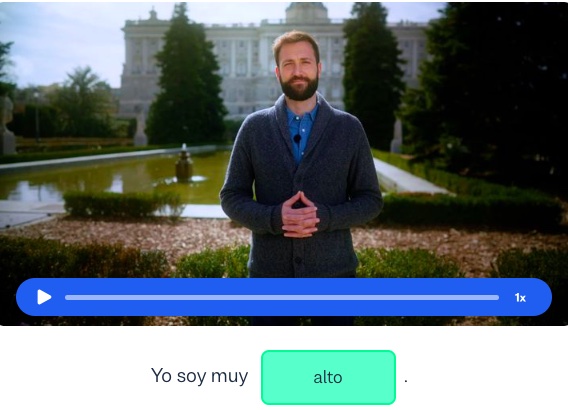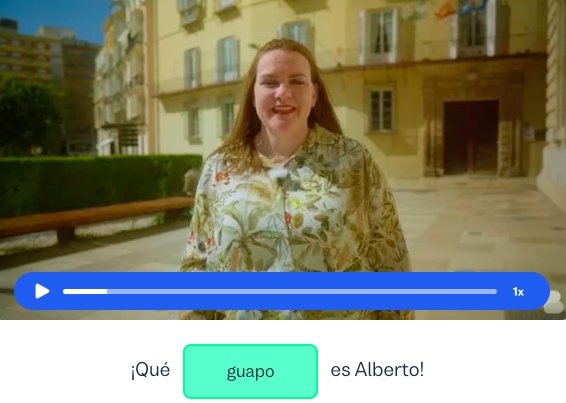35 Spanish Adjectives to Level Up Your Vocabulary
This guide will walk you through a few ways to use adjectives in Spanish.
I want to learn...
What would Spanish music and poetry be without words that add flair to it? Those words are, without a doubt, adjectives. Saying “la mujer del vestido” (the woman in the dress) is not the same as saying “la mujer del hermoso vestido azul” (the woman in the beautiful blue dress). When adjectives are added, the phrase immediately takes on an almost otherworldly quality. It makes you want to know more about this woman. To take your Spanish to a new level, we’ve put together a list of the most common adjectives. Some are used daily and others will aim at making your sentences and conversations a bit punchier.
But before you start using this list as a handy tool, let’s learn a little bit more about adjectives.
Gender agreement with adjectives in Spanish
Let’s talk a little bit about gender agreement rules. It comes in handy when describing correspondence between words in a sentence. French and Italian speakers will find Spanish it much easier to learn than most other non-native speakers as their language uses the same rule in terms of gender agreement. On top of learning new vocabulary and conjugations, you also must make sure everything else, like nouns and adjectives matches, with respect to gender and number.
Here’s an example:
English: The stove is old. The dogs are old, too.
Spanish: La estufa es vieja. Los perros también son viejos.
In Spanish sentences, “vieja” and “viejos” both mean “old”. However, they change to match the grammatical gender of the nouns they describe (singular and feminine in the first sentence; plural and masculine in the second one).
Agreement is not a simple stylistic choice. Any native Spanish speaker will be able to catch a mismatch. They will understand what you’re trying to say, even if your Spanish pronunciation isn’t quite there yet. We always say that trying is the best answer!
Do Spanish adjectives always change form with gender?
While some adjectives like “old” change in form with gender, others don’t. Generally speaking, a masculine adjective that ends in -o or -os (in the plural) can become feminine by changing the ending to -a or -as. However, there are many exceptions to this rule. For example, the word “grande” (big) does not change in gender, but only in number. We can check this by taking the previous example and replacing the adjective:
English: The stove is big. The dogs are big, too.
Spanish: La estufa es grande. Los perros también son grandes.
In the example above (with “old”) both gender and number changed in correspondence with the noun. The only difference is the added “-s” in the second sentence. In Spanish, that is how you go from singular to plural (we’ll talk more about this later).
How can you tell if an adjective is plural in Spanish?
English and Spanish are very different languages. It shows in their grammar usage. Here’s a great example of this: in Spanish, adjectives need to be in agreement with the gender and quantity of a noun. For example, a singular adjective is used with a singular noun and a plural adjective with a plural noun. How do they become plural? By adding an -s or -es suffix.
Where do descriptive adjectives go?
You know how for businesses they say location matters? Well, in Spanish it is the same thing for adjectives. The correct location for descriptive adjectives is after the noun. When they’re placed before the noun, they aim at giving an emotional or subjective quality to the adjective. However, it’s worth bearing in mind that some adjectives can’t be placed before the noun. This is the case for demonyms, or adjectives used to express the place where someone is. If you want to talk about your Italian friend, you can say “mi amigo italiano”, but not “mi italiano amigo”. But what happens in other cases? For example, “el hombre pobre” is likely to refer to a man who’s short on money. “El pobre hombre” is probably suggesting that the speaker feels sorry for the man. Both could be translated as “the poor man”. See how placement matters? In Spanish, the order in which words are in may eliminate the ambiguity of meaning that is present in English.
OK, you now know the basics of Spanish adjectives. Let’s start with some of the most common adjectives for beginners.
35 Spanish adjectives and their meanings
Here’s a list of 35 Spanish adjectives that you can use when traveling, talking, reading or writing. The first word is masculine, ending in the letter “o”, and the second one is feminine, ending in “a”. Read, learn and practice away!
Adjectives in Spanish that describe a person
Imagine someone wants you to give a description of a person you’ve just met. Where do you begin? With the help of a few Spanish adjectives, you can give them a rough idea of what they were like.
- Pequeño/pequeña = small
- Alto/alta = tall
- Inteligente = intelligent/smart
- Amable = kind
- Bajo/baja = short
- Amistoso/amistosa = friendly
- Fuerte = strong
- Valiente = brave
- Sano/sana = healthy
- Tímido/tímida = shy
- Divertido/divertida = fun
- Feliz = happy
- Triste = sad
- Bonito/bonita = pretty/cute
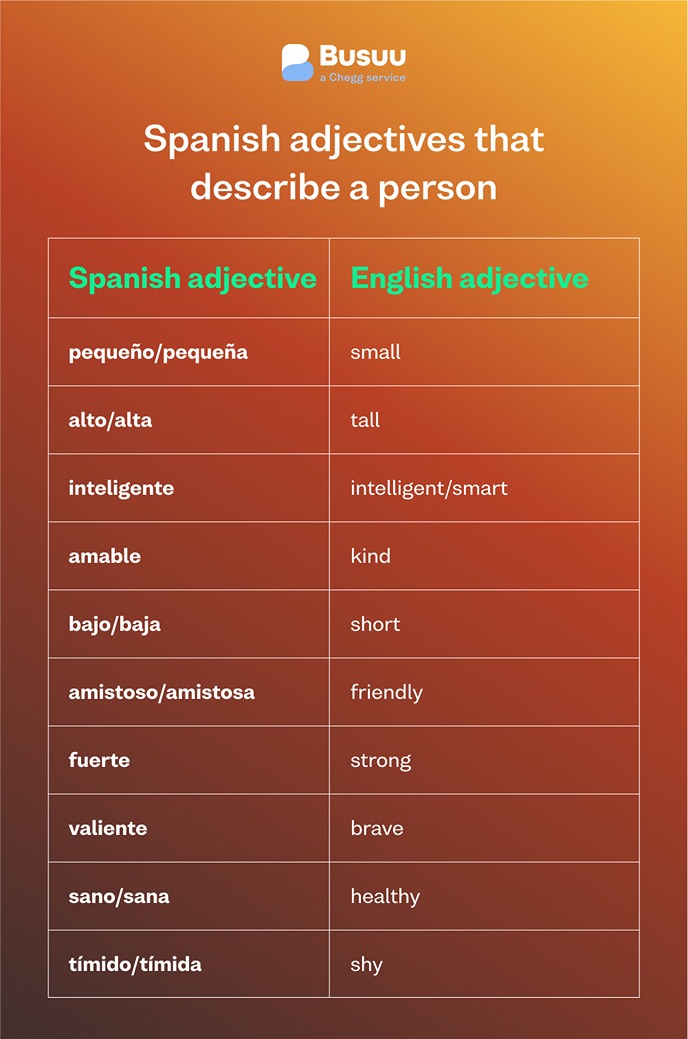
Adjectives to use while shopping or at a restaurant
Here are some useful adjectives in Spanish to use when looking around the shops in town. If you’re at a restaurant, you’ll want to be able to describe the meal as well!
- Caro/cara = expensive
- Barato/barata = cheap
- Viejo/vieja = old
- Nuevo/nueva = new
- Abierto/abierta = open
- Cerrado/cerrada = closed
- Rico/rica = rich/delicious
- Lleno/llena = full
- Vacío/vacía = empty
- Limpio/limpia = clean
- Sucio/sucia = dirty
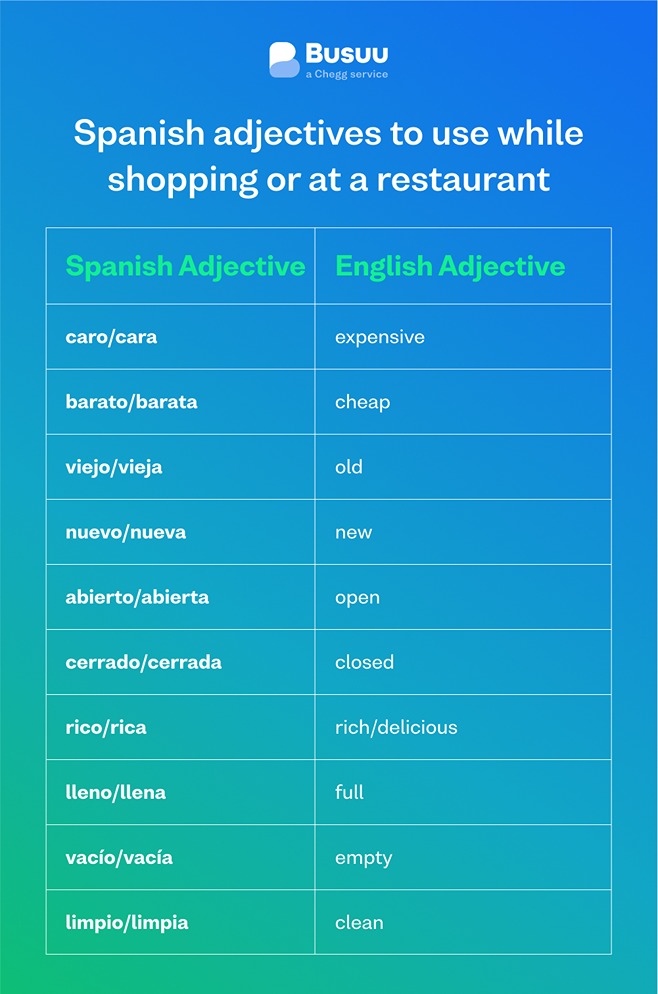
Adjectives to describe your day
Perhaps you want to talk about how fast or slow your train was, or what the weather was like. You’ll also need adjectives to describe the temperature of something. Maybe the film you saw was too long. Below are a few everyday Spanish adjectives for this purpose.
- Lento/lenta = slow
- Seco/seca = dry
- Mojado/mojada = wet
- Rápido/rápida = fast
- Bueno/buena = good
- Malo/mala = bad
- Largo/larga = long
- Corto/corta = short
- Frío/fría = cold
- Caluroso/calurosa = hot
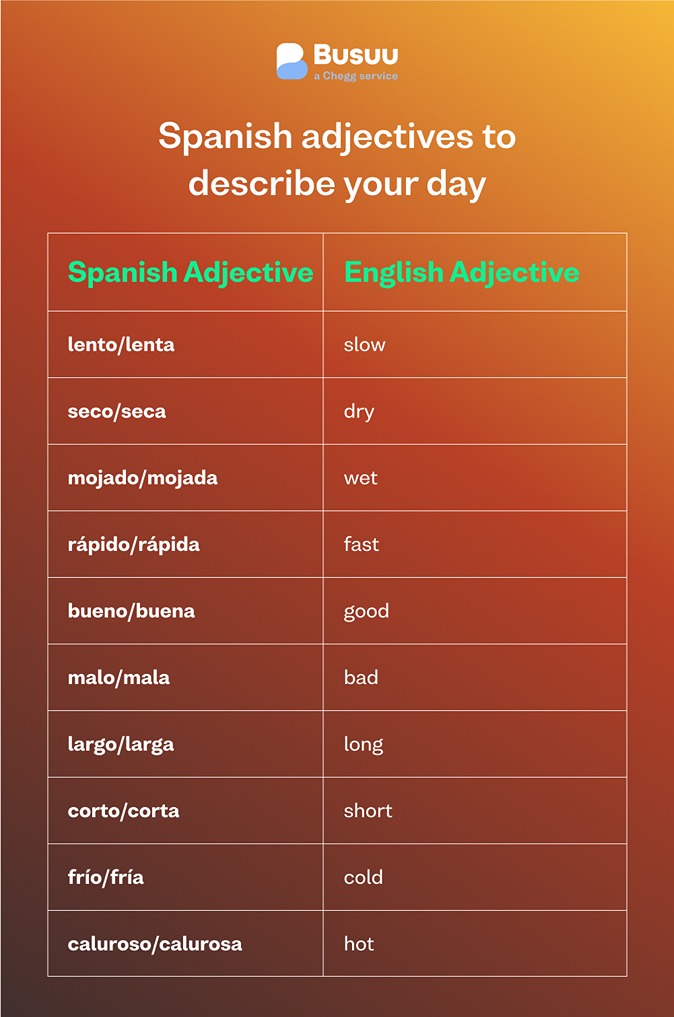
We hope this list gives you a jump start and motivates you to keep learning more Spanish every day. If you’re looking for common Spanish phrases to throw into the mix, our 48 common Spanish phrases list will help you survive any situation.
Learn Spanish or other languages today!
Busuu can help you become a native Spanish speaker in no time. Click on the button below to start learning Spanish – or one of the other 14 languages we offer!
